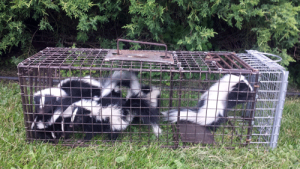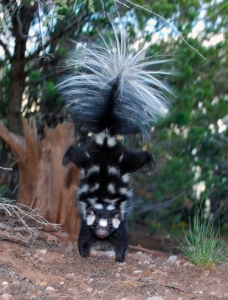What to do if a skunk sprayed me, my pet, or my yard?
 Skunks are animals known for their ability to spray a liquid with a strong, unpleasant smell. The spray is a mixture of sulfur-containing chemicals such as thiols (mercaptans) and thioacetates.
Skunks are animals known for their ability to spray a liquid with a strong, unpleasant smell. The spray is a mixture of sulfur-containing chemicals such as thiols (mercaptans) and thioacetates.
These compounds let off an immediate blast of acrid scent, reminiscent of rotten eggs. Skunk spray can be smelt from miles away and it is oily and difficult to remove completely. It permeates clothes, skin, and fur, making it last for weeks. A skunk’s odor will last 14-21 days if left untreated. And the longer you wait to wash it off, the harder it will be free of that nasty odor. If I got sprayed by a skunk, I would take a bath or shower immediately. Research shows that the spray easily soaks into skin, giving a body odor that no deodorant can tackle. I would also use dishwashing soap in liberal amounts because it is the best grease cutter available. Skunk spray smell is super strong to keep predators away. Therefore, I will have to take more than an extra measure to get the smell off. The pungent smell in skunk spray is usually caused by the sulfur which is neutralized by chlorine bleach (chlorine powder or chlorine tablets used in swimming pools). After showering with detergent, I will prepare myself a chlorine water bath. Taking a bath with chlorine powder for fifteen minutes should be helpful towards getting rid of the spray smell. However, I would not be using the chlorine bleach we use in the laundry. It’s very concentrated, highly alkaline, and not safe to bathe in or get on your skin. It will completely dissolve hair. Chlorine bleach is caustic and toxic. In case I am unable to find chlorine powder, the next best thing is baking soda. It is also alkaline, but not caustic or toxic. Baking soda is also a great deodorizer because it is alkaline. My alternative to chlorine powder would be taking a bath in water tossed in 4 cups of baking soda, making sure the baking soda has dissolved completely. Having a soak for fifteen minutes should do it and I can go without rinsing as a baking soda bath will not hurt me, as long as I am not itchy or uncomfortable. This way the baking soda will still be deodorizing. Following this process should help me feel and smell better. I can repeat this process the next day to get rid of any remaining odor.
 If a skunk sprayed my pet, I would first check if his/her eyes are red or irritated and immediately flush them with cool water. Secondly, I would have to prepare to bath my pet. Using 1 quart of 3% hydrogen peroxide solution, 1/4 cup of baking soda, and 1 teaspoon of liquid dishwashing soap I would prepare a bath for my pet to get rid of the skunk smell from his/her fur and body. I would be wearing rubber gloves to work the solution into my pet’s coat washing him/her thoroughly. However, I have to make sure not to leave the solution on his/her fur for too long since peroxide can bleach his/her fur. I will then rinse my pet. This process may have to be repeated more than once to get rid of the smell completely. If any of the skunk smell gets on me during the bathing process, I will wash my clothes in regular laundry detergent and 1/2 cup of baking soda. A few things to note while proceeding with this process are that:
If a skunk sprayed my pet, I would first check if his/her eyes are red or irritated and immediately flush them with cool water. Secondly, I would have to prepare to bath my pet. Using 1 quart of 3% hydrogen peroxide solution, 1/4 cup of baking soda, and 1 teaspoon of liquid dishwashing soap I would prepare a bath for my pet to get rid of the skunk smell from his/her fur and body. I would be wearing rubber gloves to work the solution into my pet’s coat washing him/her thoroughly. However, I have to make sure not to leave the solution on his/her fur for too long since peroxide can bleach his/her fur. I will then rinse my pet. This process may have to be repeated more than once to get rid of the smell completely. If any of the skunk smell gets on me during the bathing process, I will wash my clothes in regular laundry detergent and 1/2 cup of baking soda. A few things to note while proceeding with this process are that:
– The mixture described should not be stored as it can explode if kept in a closed container
– I have to be careful in not getting the solution into my pet’s eyes.
– Don’t use a hydrogen peroxide solution stronger than 3% as it can irritate my pet’s skin.
To get rid of skunk spray in my yard, I would have to go with a homemade remedy. Several chemical products are designed to remove skunk odor from surfaces in your home and on your clothes. However, these aren’t always safe to use on your plants. Spraying your plants with these chemicals can leach dangerous toxins into the soil, killing your bushes and nearby plants. Making my own skunk odor removal spray is the only way to make sure I use only plant-safe ingredients. The ingredients must neutralize the smell without introducing harmful chemicals. The spray is made using 1 quart of 3 percent hydrogen peroxide, 1/4 cup baking soda and 1 teaspoon of liquid dishwashing soap and mixing it in a large bowl to release oxygen which causes an explosion in closed containers. The spray mixture is to be used immediately. The technique to using the spray is by dipping the bottom tube of a spray nozzle in the solution inside the bucket or bowl since we cannot put a lid on it. Spray it evenly over the leaves, branches and soil, but don’t saturate the area; too much hydrogen peroxide at one time can harm the bushes. If it doesn’t remove all the odor, reapply the solution every other day until the smell is gone. Hydrogen peroxide is safe to use on your bushes if diluted properly, which is why a 3 percent solution is ideal. As it releases oxygen around the roots, it helps prevent root rot, which can be especially helpful in dense or poorly draining soil.
